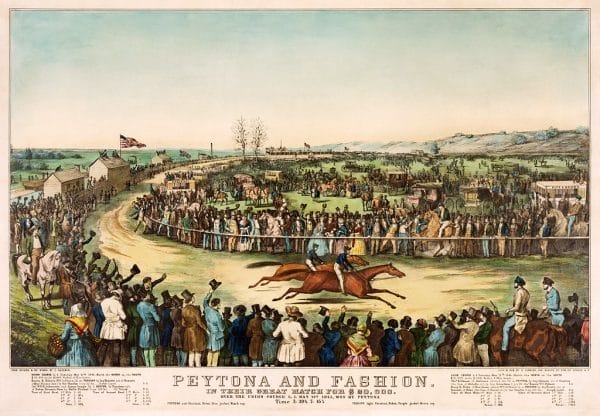James Jackson
 James Jackson Portrait
James Jackson (1782-1840) was well-known as one of the founders of Florence and surrounding Lauderdale County. He established the Forks of Cypress plantation house near Florence and was the first breeder and importer of race horses in the United States. Jackson was also a planter, surveyor, land speculator, and politician.
James Jackson Portrait
James Jackson (1782-1840) was well-known as one of the founders of Florence and surrounding Lauderdale County. He established the Forks of Cypress plantation house near Florence and was the first breeder and importer of race horses in the United States. Jackson was also a planter, surveyor, land speculator, and politician.
Born to James and Mary (Steel) Jackson on October 25, 1782, in Ballybay, County Monaghan, Ireland, Jackson was educated in Ireland and worked there as a civil engineer. He came to America in 1799, lived briefly in Philadelphia, Pennsylvania, and moved to Nashville, Tennessee, in 1801. There, he met Sarah (Sally) Moore McCulloch in 1809, and they were married on December 28, 1810. Sally had a child from a previous marriage, and she would have 10 more with James Jackson. One son, James Jr., served as a lieutenant colonel in the Confederate Army during the Civil War and took part in several campaigns and later served as probate judge of Lauderdale County.
In Nashville, James Jackson worked as a surveyor and quickly became acquainted with Andrew Jackson (no relation) and John Coffee, who were founders of the Tennessee Land Company. They soon merged with the Alabama Land Company to form the Cypress Land Company. James Jackson was a member of the Tennessee group and became one of the seven trustees of the Cypress Land Company. The company and its members were instrumental in founding Lauderdale County and the city of Florence.
 Forks of Cypress Interior
Jackson purchased land in the forks of the Big and Little Cypress Creeks near Florence and had a large plantation home built there. Designed by architect William Nichols, the Forks of Cypress mansion was completed in 1830 and the surrounding property encompassed 3,000 acres of land. Jackson and his family made Forks of Cypress their primary home, but he also owned a plantation in Mississippi.
Forks of Cypress Interior
Jackson purchased land in the forks of the Big and Little Cypress Creeks near Florence and had a large plantation home built there. Designed by architect William Nichols, the Forks of Cypress mansion was completed in 1830 and the surrounding property encompassed 3,000 acres of land. Jackson and his family made Forks of Cypress their primary home, but he also owned a plantation in Mississippi.
Jackson was a Presbyterian and a Whig. He was elected to the Alabama General Assembly in 1822, held offices in both state legislative branches, and served as president of the Senate from 1831-32. While he was president of the Cypress Land Company, the group donated the land for the Florence Synodical Female College, the Methodist, Episcopal, and Presbyterian churches, and the Lauderdale County courthouse.
 Peytona vs. Fashion Horse Race
Jackson left politics soon after to concentrate on importing, breeding, and racing horses. He had owned thoroughbreds as early as 1807 but did not begin importing and breeding them in earnest until he left his political career. In 1830, Jackson imported Leviathan from England, and the horse would become the sire, or father, of most of the top racehorses of the period. Leviathan, a dark chestnut who stood 16 hands high, was bred to many of Jackson’s mares; several of Leviathan’s female offspring were in turn bred to famed racehorse Glencoe. This horse, which Jackson purchased and imported in 1835, was once owned by King George IV of the United Kingdom and would sire more than 450 foals. Jackson sold the majority of his foals out of Glencoe to southern racehorse enthusiasts, including noted Louisiana horse racer Thomas J. Wells. In 1836, he imported the mare Myrtle, and her extended progeny included notable racers Magnolia, Maggie B.B., Iroquois, Crusader, and Gallopade. Peytona, an offspring of Glencoe, was one of the most famous Forks of Cypress horses. Peytona has often been considered the best of Jackson’s racehorses, as well as the best of Glencoe’s line. Glencoe also sired other notable horses such as Reel, Pryor, and Vandal. Glencoe and Leviathan were painted by noted equestrian portraitist Edward Troye.
Peytona vs. Fashion Horse Race
Jackson left politics soon after to concentrate on importing, breeding, and racing horses. He had owned thoroughbreds as early as 1807 but did not begin importing and breeding them in earnest until he left his political career. In 1830, Jackson imported Leviathan from England, and the horse would become the sire, or father, of most of the top racehorses of the period. Leviathan, a dark chestnut who stood 16 hands high, was bred to many of Jackson’s mares; several of Leviathan’s female offspring were in turn bred to famed racehorse Glencoe. This horse, which Jackson purchased and imported in 1835, was once owned by King George IV of the United Kingdom and would sire more than 450 foals. Jackson sold the majority of his foals out of Glencoe to southern racehorse enthusiasts, including noted Louisiana horse racer Thomas J. Wells. In 1836, he imported the mare Myrtle, and her extended progeny included notable racers Magnolia, Maggie B.B., Iroquois, Crusader, and Gallopade. Peytona, an offspring of Glencoe, was one of the most famous Forks of Cypress horses. Peytona has often been considered the best of Jackson’s racehorses, as well as the best of Glencoe’s line. Glencoe also sired other notable horses such as Reel, Pryor, and Vandal. Glencoe and Leviathan were painted by noted equestrian portraitist Edward Troye.
Jackson died on August 17, 1840, and was buried in the Jackson Family Cemetery near Forks of Cypress. Jackson willed his horses to his nephew, Thomas Kirkman, who was married to his stepdaughter, Elizabeth McCulloch Kirkman. Thomas Kirkman was notable for anonymously publishing two Old Southwest humor stories. He continued racing horses, and on May 13, 1845, Peytona defeated the New Jersey-bred Fashion in a race held at Union Course, New York. Billed as a contest between the North and the South, the race generated massive media attention, with the New York Herald sending eight reporters to cover the event. Carrier pigeons were used to carry the news to those waiting on the mainland. The Civil War ended the era of horse-breeding at Forks of Cypress, but the famous bloodlines live on, as did Jackson’s renown as a breeder.
Additional Resources
Anderson, James Douglas. Making the American Thoroughbred. Norwood, Mass.: Plimpton Press, 1916.
McDonald, William Lindsey. A Walk Through The Past: People and Places of Florence and Lauderdale County, Alabama. Florence, Ala.: Bluewater Publications, 2003.
O’Neal, Elizabeth Kirkman. The Forks of Cypress: Home of James and Sally Moore Jackson. Waring Sherwood, 1966.


